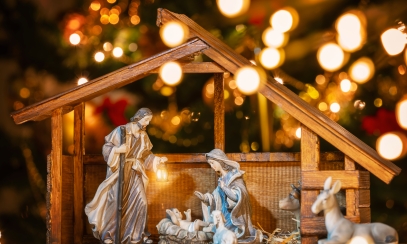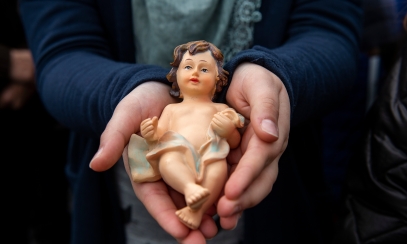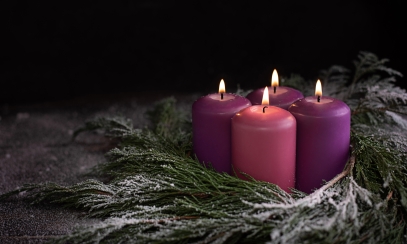
How to Pray Like a Monk
September 14, 2022 | I was on my way with a friend to a retreat in the hills of Kentucky. We were going to the Abbey of Gethsemani to spend a week of prayer with the Trappist monks. They are a community of men who consecrate their lives to God through Christ by living a life of prayer and work. They follow closely the Rule of St Benedict that has guided monastic living in the West for 1500 years. Their formal title is the Order of Cistercians of the Strict Observance. While that title might scare a lot of people off, it apparently does not keep retreatants away, because we were informed that the retreat house was almost always full. There is a hunger and thirst for Christ in all of us, and our Lord moves us to seek his face.
Upon arrival at the monastery, we entered into silence. No TV. No phone. No radio. No Internet. Only the sound of nature, or the bell calling us to prayer, or the voices of the monks singing and chanting praise to God. Silence was the discipline that really stood out in great contrast to our noisy world. The monks would speak and sing to God in prayer but would only speak to one another when needed. “Be still and know that I am God!” Such a discipline helped create and maintain the condition for prayer. Another beautiful discipline characteristic of Benedictine spirituality is their liturgical focus. They pray the psalms throughout the day and night and celebrate the Eucharist each day. Praying the 150 psalms in a structured way is called the Liturgy of the Hours. At seven designated times during the day and night, the monks gather to pray and to hear God’s word. They join with Christians all over the world to praise, thank and petition God. The idea is that time itself is sacred and a gift from God. What better use of time is there than to spend it with God? St Paul urges us to pray always. So, the monk’s life is dedicated to the Holy Spirit’s work of sanctifying time through prayer. It was a powerful experience to be able to join the monks in prayer. I had a sense of being swept up with the angels in praise of the living God.
Another dimension of Benedictine spirituality is the discipline of fasting. Most of the monks looked healthy but pretty thin. The food we ate was simple – mainly vegetarian cuisine. It is a little ironic that, in their work, Trappist monks produce delicious food items like cheese, fruitcakes, fudge, wine or beer to help them pay their bills. I wondered if they ever eat the fruit of their own labors? Besides the cheese, it certainly did not look like it! The monks’ labor reminded me of St Paul who worked as a tent-maker during his ministry so as not to burden anyone. The monks have renounced the world to dedicate their lives to God through communal life and prayer. As a community, they are salt and light for our world.
Hospitality is very important for all Trappists and other Benedictines. To welcome the stranger out of love for Jesus Christ is a part of their Benedictine spirituality and rule, and we certainly experienced that immediately from the monk who greeted us at the airport. When our monk chauffer realized we had not eaten anything all day, he took us to a place that offered a tremendous buffet. He realized that, once at the monastery, the food would be wholesome, but might be a big change from our normal diet. “So eat up!” That buffet got me to think of the Messianic banquet prepared for us by Christ. It was overflowing. “Come to me, all you who labor and find life burdensome, and I will give you rest.” (Mt 11:28)
“Come to the water, all you who are thirsty! You who have no money, come, receive grain and eat; Come without paying and without cost, drink wine and milk.” (Is 55:1) We did! There was so much to pick from – a wide variety of food that satisfied all. It was a good appetizer to the real feast of the retreat.
The same could be said for Catholic spirituality. All Catholic spiritualities draw us to the Messianic banquet of Christ. At a banquet, it is true we can pick and choose what we want to feast on. That analogy does not always work with regard to our faith. We do not pick and choose parts of the Gospel or Catholic teaching to live or believe in. When we follow Jesus, we must pick up our cross, die to self and sin, and follow him through death to resurrection. We live out our baptism in Christ. That is central to all Catholic spiritualities. Without the paschal mystery – the mystery of Christ’s death and resurrection – there is no Catholic spirituality.
However, in terms of Catholic spiritualities, there is a sense of being in a banquet or buffet line. There is so much there! Another helpful image is that of a garden. Our Lord has established the church almost as a new Garden of Eden. In Eden, God gave human beings many kinds of fruit trees from which to eat. In the church, God has also given us many variations of Gospel life that may differ in expression, differ in spiritual gifts and ministry, differ in focus and devotion, but don’t differ in their essence. They are Catholic because they spring from the heart of Christ, are rooted in him and reveal in their own unique way the power of his death and resurrection that transforms the person into another Christ.
All Catholic spiritualities have Christ as their center and are movements of the Holy Spirit to further draw the soul to complete union with God. Benedictine spirituality is one of them, and has blessed the church for nearly 1500 years, but there are many more. Just in terms of religious orders – there are hundreds of them!
In reflecting on the more familiar ones, we have religious men and women who are drawn by God to truth and so often minister in the church as teachers. The Order of Preachers, or Jesuits, or Benedictines would be an example. There are those who are drawn to the poor by love and charity and want to spread that love through acts of service. The Missionaries of Charity and Franciscans are great examples. There are religious orders whose members are drawn to lives of prayer and contemplation, among them the Carmelites or Trappistines (female branch of the Trappists), or Poor Clares.
There are religious orders whose members run hospitals, or who have ministries of healing or evangelization. To list them with some explanation would take many books! The more one looks, the more one realizes how large is this garden of God we call the church in its expression of Christian life. How truly beautiful it is. It is truly the mustard seed that has grown into the largest of shrubs with room on its branches for all.
This month, consider your own spirituality and ask the Lord to help you grow and expand your own horizons:
Consider how the Lord is drawing you to himself. In your life with Jesus, what devotional practices have you incorporated that help you draw closer to him?
Consider learning more about religious orders. There are many new religious orders forming all over the world. Many orders have lay members or lay associates who are drawn to imitate the life and practice of the order without taking formal vows.
Read a spiritual book on the life of a saint or holy person and think about his or her spirituality. How could you better imitate his or her example? (One possible suggestion would be Thomas Merton’s book, Seven Storey Mountain, which is an autobiography of Merton’s conversion and path to monastic life.
Go on a retreat. Enter into the quiet! Let God speak to your heart. Do whatever he tells you.
Fr. Bill Ashbaugh is the pastor of St. Thomas the Apostle Church in Ann Arbor, MI. Fr. Bill was studying to be a scientist when God called him to the priesthood and we was ordained a priest in 1993.



